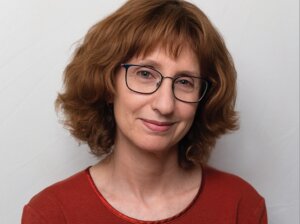How Family Holocaust Stories Became Multimedia Art Exhibit

Image by Aliza Augustine

Image by Aliza Augustine
A version of this article appeared in Yiddish here.
Children of Holocaust survivors can be split into two groups: those whose parents or grandparents said nothing about those harrowing years, and those whose relatives gave them detailed accounts of their experiences.
I belong to the first category. Although my father’s family had, like all the Jews of Chernivtsi (known in Yiddish as Chernovits), been crammed into a ghetto, he never told any of us children about it. Whenever I asked about his experience, his reply was, “I don’t remember.” The subject was probably too painful for him to discuss.
But Aliza Augustine and Janet R. Kirchheimer are of the second category. Throughout their childhood, their relatives gave them detailed accounts of their experiences during the war. Today, both women feel a personal responsibility to share their stories with the next generation — not simply by telling people what happened, but by portraying the experience through the arts. Augustine does it through photography, and Kirchheimer through poetry and film.
The two women met two years ago at a conference for children of Holocaust survivors and began discussing how they could use their art to further Holocaust remembrance. The result of their collaboration is now on view until May 18 at the Human Rights Institute Gallery at Kean University, in Union County, New Jersey, in an exhibit titled “How To Spot One of Us.”
One part of the exhibit features Augustine’s narrative portraits of grown children of survivors, each displaying an old family photograph and set against a contemporary landscape photographed by Augustine during a trip to Europe in 2013. One of the portraits is of Kirchheimer.
Accompanying the portraits is a mixed-media series using Augustine’s 2013 photographs and Kirchheimer’s poems, as well as Kirchheimer’s 2013 film, “How I Knew and When,” which is based on one of her poems. The short film stars Kirchheimer and her mother. and provides poignant vignettes of their relatives’ experiences both during and immediately after the war.
Kirchheimer relates that when she was 21 years old she found out that her tante, her aunt, Emilia had told her mother that “on the Queen Elizabeth to America in 1947, after she and Uncle Dovid were released from an internment camp on the Isle of Man, she was so hungry, she ate 12 rolls each day at breakfast. She said it was the best time she ever had.”
Throughout the three and a half minute film, a violin plays a somber melody as Kirchheimer and her mother talk in a dirgelike monotone, as if trying desperately to contain the anguish under the surface.
Augustine, a professional photographer, decided to devote her art to Holocaust remembrance after years of listening to what happened to her father, uncle and grandparents during the war. The one who gave her the most information was her grandfather. “He was a furrier, and I used to go to his shop, watch him work with fur, and that’s when he would tell me the stories.”
He told her he was put to work in Vichy France as a translator in the concentration camp, Le Vernet. Since he had access to lists of people about to be deported, he often warned those whose name appeared in order to give them a chance to escape. On the morning that he saw his own name on the list, he managed to sneak out with his wife, his two sons and a group of other people, trekking through the Pyrenees Mountains until they arrived at the border between Spain and Portugal. The adults and children were separated, and everyone was placed into crates, which were pulled by rope through a body of water until they reached Portugal.
In January 1943, Augustine’s father and uncle, who at the time 9 and 14, respectively, were taken onto the ship S.S. Serpa Pinto which brought them to America. They were placed in an orphanage in Newark, New Jersey for six months, until they were finally reunited with their parents.
Augustine’s grandfather died in 1994. And although she has two younger brothers and several cousins, Augustine is the only one who knows the details of her family’s experiences during the Holocaust. “Sometimes, they’ll ask me questions, but they don’t remember the answers, so they end up asking the same questions again and again,” she said.
For those people who don’t have Augustine’s and Kirchheimer’s deeply emotional connection to the Holocaust, simply passing on the facts is apparently not enough. The goal of their exhibit is to reach visitors on a visceral level through photographs, poetry and film.
As the Israeli writer Aharon Appelfeld once wrote: “After the death of the last witnesses, the remembrance of the Holocaust must not be entrusted to historians alone. Now comes the hour of artistic creation.”
Rukhl Schaechter is the news editor of the Forverts. Contact her at [email protected]























